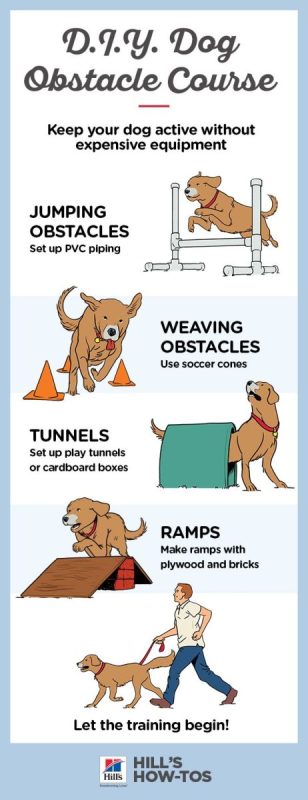
How to make an obstacle course for your dog
Do you enjoy spending time with your dogs and would like to train them using an obstacle course, but it seems that if there is no specially equipped training area near you, it is very difficult to build one? We hasten to please you: most likely, you have all the necessary materials and equipment in order to build such an obstacle course. If the dog does not yet know how to pass obstacles or you do not have training experience, this is also not a problem. Teaching a dog to overcome many elementary obstacles is not difficult. Start with simple exercises, snake and tunnel, and both of you will soon become professionals.
Before building an obstacle course for a dog, keep in mind that you must have enough space for each obstacle and, in addition, additional space for safety. All simulators should be made of lightweight materials so that the pet does not get injured during training. Be patient and the training process will bring positive emotions for you and your dog.
Jump obstacles
If both you and your dog are new to agility, the best place to start is with jumping. For training a four-legged friend in simple jumps, simulators made from unnecessary household items, such as laundry baskets and cornices, are quite suitable, or perhaps you still have extra PVC pipes after repairs? You can make a wonderful obstacle course barrier out of them!
For jumping training, it is best to use movable bars so that you can adjust the height according to your dog’s skills. Instructions on how to make a PVC pipe barrier can be found at Instructables.com.
Do you have a gymnastic hoop or noodle (aqua stick) for swimming? They are made of soft materials and therefore they are also suitable for training jumping obstacles. During the first training, you can simply hold the obstacle at a suitable height and command your pet to jump over it.
All simulators of this kind should be light and collapsible so that the pet does not get injured.
Slalom type obstacles
Have your kids played sports and still have orange training cones? They are perfect for teaching your dog how to walk the snake. Place the cones in a line about one meter apart in the yard.
Also, any light objects or sticks in the form of racks are suitable for the formation of this simulator. The height of the cones is, of course, smaller than the height of the dog, which can make training difficult, but if you use light sticks, he will immediately understand that he needs to “snake” between them.
Racks must be stable and not fall every time the pet passes an obstacle. However, as with jumping aids, they must be light enough so that the dog does not get injured if it crashes into such a rack. Do not place obstacles too close or too far apart.
You need to start slowly: let the dog go through the racks first, and only then you can give her the command to run. It is more effective to lead a dog on a leash through each bar and give him a treat when he completes the task, or use the treat as bait to follow him through the bars. Use appropriate verbal commands or gestures to get your dog to associate your commands with the actions he needs to perform.
Tunnel obstacles
There are many ways to make a tunnel from improvised items. Your children have grown up, but you still have a children’s tunnel? These tunnels are light and can be dismantled, so they are great for dog training. In addition, it can be stored folded – so it takes up very little space.
For dogs that have not yet been trained to pass an obstacle, the tunnel can be replaced with a cardboard box without a bottom – with such a projectile they will also have fun. During training, you will have to support the box. To begin with, short tunnels 1,2-1,5 meters long can be used so that the dog gets used to the very idea that he needs to go through them.
If your dog is new to this type of training, he may not want to go through tunnels. You just need to cheer her up. Get on all fours, crawl through the tunnel yourself, and she will follow your example. You can also lay out treats at the beginning, middle, and end of the tunnel for your pet to walk through. Again, as with other training, you need to be consistent and give such commands so that the puppy understands exactly that he needs to go through the tunnel.
Gorki
Slides can be another fun project for your obstacle course. The slide can be made from plywood or other building materials, but you need to make sure they are strong and safe for your pet: he will run up and down, and the slide must withstand this load and not move.
Time for a change
As your dog begins to master the projectiles and overcome each obstacle simply by following your verbal commands or gestures, change the order of the obstacles. Thanks to this, he will not only perform a set of actions in a certain order, but will understand that the passage of each obstacle is preceded by its own special command.
Want to diversify your workouts? Make your obstacle course more difficult with additional tasks: for example, after passing all the projectiles, instruct the dog to bring you a tennis ball or a toy. If you’re training in warm weather during the summer, install sprinklers in your obstacle course to keep your dog warm. But do not let water get on the slides, otherwise your pet may slip and hit.
If you decide to set up an obstacle course, your dog will have a lot of fun going through it. In addition, the strip will provide her with the necessary physical activity, and you will have a lot of fun watching your pet overcome one obstacle after another. When your four-legged friend masters the obstacle course, you can measure the time and find out how many minutes it takes him to complete the entire obstacle course. Who knows, suddenly he will become a professional!





